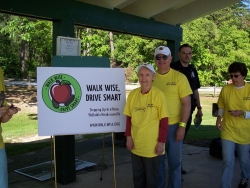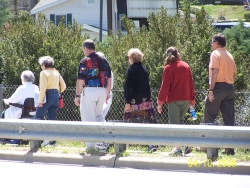Walk Wise, Drive Smart
Hendersonville, North Carolina
Source: Pedestrian and Bicycle Information Center (PBIC)
Problem
As more Americans reach age 65 and older, safety concerns for senior pedestrians are growing. Walking is a key to maintaining physical and mental well being and it enables senior adults to stay connected to their community, but several fears and dangers keep elderly adults from walking. For example, senior pedestrians involved in a crash are much more likely than younger pedestrians to suffer serious or fatal injury. The fear of falling also keeps older adults from walking, for as many as one-third of adults 65 years old and older fall each year.

A walk-wise kick off event. Image courtesy of www.walk-wise.org.
Background
Over 31% of Hendersonville's population is age 65 and older, which makes it an ideal candidate for a senior pedestrian safety program. Walk Wise, Drive Smart is a program aimed to improve the pedestrian environment in Hendersonville not only for senior adults, but for all residents and visitors alike.
Solution
Walk Wise, Drive Smart is a community-based pedestrian safety program working to build community support for an awareness of senior-pedestrian safety issues. The program holds educational workshops and walking audits of Hendersonville neighborhoods, gathers extensive community feedback through surveys and interviews, and identifies elements that are needed for the implementation of a pedestrian safety plan.
Since the Walk Wise, Drive Smart program started in 2006, several programs have been held to promote senior pedestrian safety. Walk Wise walking routes are recommended walking routes that cater to the needs of older pedestrians. The first Walk Wise route was completed in December 2007 with the help of the Walk Wise, Drive Smart team, representatives of the City of Hendersonville, and the Council on Aging for Henderson County. These volunteers designed a 1.5 mile route while paying particular attention to the needs of older adults. Along the route orange paint was used to mark areas where walkers need to exercise extra care because of potential tripping hazards.

A walk-wise group performs a walking audit. Image courtesy of www.walk-wise.org.
Another Walk Wise, Drive Smart program was a campaign that was held in the fall of 2007 to educate and reward drivers who stopped at crosswalks for pedestrians. Drivers who yielded properly to a pedestrian in a mid-block crossing, stopped behind the stop bar at an intersection, or correctly made a right-turn-on red turn were handed a postcard that could be entered in a drawing for monthly prizes. Drivers who do not properly stop for pedestrians were reminded of the proper procedure and told about the postcards for future reference.
Results
Walk Wise, Drive Smart has had several successful events and programs. Frequent organized walks aimed at senior citizens but open for all provide a great way to get seniors to exercise at a pace and location that is comfortable for everyone who participates. The Walk Wise, Drive Smart program is a great model for other communities to follow to provide pedestrian facilities that are safe for all age groups.
For more information, read the Walk Wise, Drive Smart final report, available at http://www.pedbikeinfo.org/data/library/details.cfm?id=4350.
Contact
Bill Hunter
Senior Research Scientist
Highway Safety Research Center
Phone: 919-962-8716
Email: bill_hunter@unc.edu
Website: http://www.walk-wise.org/




